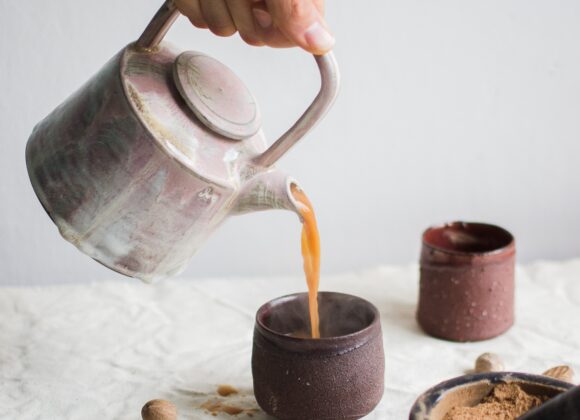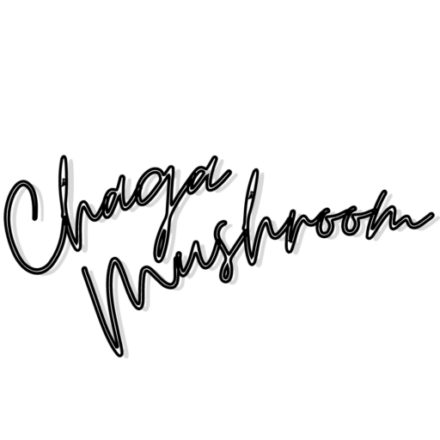Chaga (Inonotus obliquus) is a fungus, mainly growing on birch trees. It’s historically known to be used in folk medicine since the 1500s. Chaga contains massive amounts of the pigment melanin, therefore in exposure to sunlight, the exterior of the mushroom will turn deep black, while the interior will stay a bright orange color. So can Chaga darken your skin?
Chaga is known as one of the highest natural melanin sources in the world. It turns out that melanin has high antioxidant levels due to the number of polyphenols it contains. Meaning consuming Chaga will support your cells and help to keep balanced levels of melanin in the body.
To put it simply, melanin found in Chaga will not darken your skin but supports your skin’s health. Therefore Chaga won’t darken your skin deep, but mixing a rich-colored Chaga tea into your cream adds a beautiful natural pigment and a healthy glow to the skin.
How does melanin affect your skin tone?
We all have something in our skin called melanin, the pigment responsible for our beautiful variety of skin tones and shades, eye colors, and hair colors.
The cells in our epidermis that make melanin are called melanocytes. It turns out that everyone has the same number of them but the pigment of your skin, eyes, and hair color is determined by which kind of melanin and how much of it these cells produce. Your body’s natural production of melanin is based on your genetics.
Inside the melanocyte are melanosomes, which are responsible for producing the two kinds of melanin.
1) Eumelanin – a darker pigment
2) Pheomelanin – a light-colored pigment
Melanin in Chaga
Despite the melanin state in your body, research has actually shown that Chaga mushroom supports healthy and balanced levels of melanin in the body.
The sclerotium, otherwise known as the dark, almost black outer layer of Chaga contains massive amounts of melanin. Chaga is even known as one of the highest natural melanin sources in the world. It turns out that melanin has high antioxidant levels due to the number of polyphenols it contains, meaning consuming the fungi will help to keep your cells healthy. In fact, Chaga has the highest Oxygen Radical Absorbance Capacity (ORAC) score of any superfood, ranking three times higher on the scale than acai berries. The research studies are ongoing to discover whether these advantages can be used as the basis for establishing anti-cancer medications from “The king of mushrooms”. If you’re interested in learning more about the health benefits of Chaga head over to our post “Health Benefits”.
Since your skin tone is determined by the type of melanin produced in your body, the pigment found in Chaga doesn’t play a role in darkening your complexion skin deep. If you’re looking for ways to enhance your complexion experiment with topical recipes. We have heard of people mixing Chaga tea with strong rich colors into their creams, to add a beautiful natural pigment and healthy glow to the skin.
To learn more head to our recent article on “Does Chaga increase melanin?”.
More Chaga benefits for skin health
Chaga contains a form of Betulonic acid, that is infamous for skin regeneration. The fungi will improve your skin’s elasticity, by aiding collagen production. Supporting your skin restoration back to health will inevitably improve the natural look of your skin!
It’s packed with enzymes that work wonders for keeping skin moisturized and healthy, whilst keeping away clogged pores, and dirt build-up – the microscopical causes of acne.
The antioxidants found in Chaga help your skin prevent the onset of wrinkles, aging, and discoloration due to defense against the inescapable free radicals.
Chaga is naturally anti-inflammatory, meaning it calms the skin and helps to reduce areas of skin inflammation. Improving both pain and function, by treating the skin and supporting the health of your immune system, to reduce future outbreaks.
How to find Chaga?
Chaga thrives in cold, damp conditions, and has a great tolerance for surviving hard winters. You can find the mushrooms in abundance in the northern hemisphere where it has higher forest altitude, like the northern deciduous forests.
Unlike many other fungi, Chaga starts growing from inside the tree, instead of developing on the surface of the tree. As it matures, it protrudes from the tree.
Harvesting chaga
Ultimately the best time to harvest Chaga is during fall or winter when the visibility is better, due to fallen leaves and the temperature is below 5 degrees Celsius. That is when the sap starts to run. The sap is the fluid that is found in the fungi, containing dissolved mineral salts and nutrients.
If you’re planning to go Chaga hunting yourself, “Best time to harvest Chaga” contains more tips and tricks on how to prepare.
Buying chaga
Nowadays you`ll be able to find various different companies, products, and suppliers of the mushroom. The is between teas, coffee powders, extracts, supplements, and a lot more.
Three product groups you’ll find most, are the following:
1. Powder
Chaga powder is the chunks of the fungus grounded used to make tea, broth, tincture, and more. For more inspiration, check out our recipes.
2. Dual extract
Dual extract stands for the double extraction method. When done right, this is the most potent Chaga product available, taking quite a bit of time and effort to make (which reflects in the price).
3. Dried chunks
By that, we mean raw harvested Chaga that has been cut into pieces and dried. You’ll be able to grind the chunks in a food processor or a coffee grinder yourself. The benefit of dried chunks to purchasing a powder is the quality assurance. Like being able to check if the outer layer – sclerotium is still intact to support your melanin levels and cells. Dried Chaga chunks can also be reused up to 5/6 times before losing their potency.










